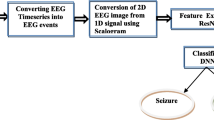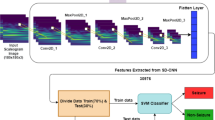Abstract
The classical Wavelet Transform (WT) is still useful and highly popular analysis method, especially for non-stationary signals like biomedical ones. Unfortunately, performance of the WT is very much depending on the chosen mother wavelet. ConceFT (concentration of frequency and time) is a brand-new time–frequency (TF) analysis method which combines multitaper technique (MT) and synchrosqueezing transform (SST). This combination produces highly concentrated TF representations with approximately perfect time and frequency resolutions. Also, ConceFT undermines the importance of the mother wavelet. ConceFT approach produces same TF representations for different mother wavelets owing to combination of MT technique and SST. In this paper, we aim to show the TF representation performance and robustness of ConceFT by using it for the solution of the epileptic seizure detection problem. We propose a seizure detection algorithm which uses ConceFT as a TF method and transfer learning. Epilepsy is a common neurological disorder that millions of people suffer worldwide. Daily life of the patients is very difficult because of the unpredictable time of seizures. Electroencephalography signals that monitor the electrical activity of the brain can be used to detect approaching seizures and make possible to warn the patient before the attack. For evaluating the classification performance of our ConceFT-based approach, we prefer to use GoogLeNet and SqueezeNet which are the well-known deep learning models. We tested our method for various classification scenarios and obtained accuracies between 91.18 and 100% for two- and three-class classification scenarios. High results show that ConceFT is a successful and promising TF analysis method for non-stationary signals.



Similar content being viewed by others
Availability of data and material
The EEG signals used in this work can be obtained from the University of Bonn [24].
References
WHO: “Epilepsy”, https://www.who.int/news-room/factsheets/detail/epilepsy. [Accessed Oct. 12, 2021].
Fisher, R.S., Boas, W.E., Blume, W., Elger, C., Genton, P., Lee, P., Engel, J.: Epileptic seizures and epilepsy: definitions proposed by the international league against epilepsy (ILAE) and the international bureau for epilepsy (IBE). Epilepsia 46(4), 470–472 (2005)
Fisher, R.S., Acevedo, C., et al.: ILAE official report: a practical clinical definition of epilepsy. Epilepsia 55(4), 475–482 (2014)
Alarcón, G., Valentín, A.: Introduction to Epilepsy. Cambridge University Press (2012)
Freeman,W.J., Quiroga, R.Q.: Imaging Brain Function with EEG: Advanced Tem—poral and Spatial Analysis of Electroencephalographic Signals. Springer (2013)
Ropper, A., Brown, R.H.: Principles of Neurology, 8th edn. USA, McGraw-Hill, Boston (2005)
Zhang, T., Chen, W.: LMD based features for the automatic seizure detection of EEG signals using SVM. IEEE Trans. Neural Syst. Rehabil. Eng. 25(8), 1100–1108 (2017)
Ullah, I., Hussain, M., Qazi, E.-U.-H., Aboalsamh, H.: An automated system for epilepsy detection using EEG brain signals based on deep learning approach. Expert Syst. Appl. 107, 61–71 (2018)
Mohseni, H. R., Maghsoudi, A., Shamsollahi, M. B.: Seizure detection in EEG signals: a comparison of different approaches. IEEEEMBC (2006)
Kevric, J., Subasi, A.: Classification of EEG signals for epileptic seizure prediction using ANN. In: Proceedings of the International Symposium Sustainable Development, IEEE (2012)
Joshi, V., Pachori, R.B., Vijesh, A.: Classification of ictal and seizure free EEG signals using fractional linear prediction. Biomed. Signal Process. Control 9, 1–5 (2014)
Tzallas, A.T., Tsipouras, M.G., Fotiadis, D.I.: Epileptic seizure detection in EEGs using time–frequency analysis. IEEE Trans. Inf. Technol. Biomed. 13(5), 703–710 (2009)
Orhan, U., Hekim, M., Ozer, M.: EEG signals classification using the K-means clustering and a multilayer perceptron neural network model. Expert Syst. Appl. 38(10), 13475–13481 (2011)
Kaya, Y., Uyar, M., Tekin, R., Yıldırım, S.: 1D-local binary pattern-based feature extraction for classification of epileptic EEG signals. Appl. Math. Comput. 243, 209–219 (2014)
Sharmila, A., Geethanjali, P.: DWT based detection of epileptic seizure from EEG signals using naive bayes and k-NN classifiers. IEEE Access 4, 7716–7727 (2016)
Bhattacharyya, A., Pachori, R., Upadhyay et al. A.: Tunable-Q wavelet transform based multiscale entropy measure for automated classification of epileptic EEG signals. Appl. Sci. 7(4). Article ID 385 (2017)
Turk, O., Ozerdem, M.S.: Epilepsy detection by using scalogram based convolutional neural network from EEG signals. Brain Sci. 9(5). Article ID 115 (2019)
Jaiswal, A.K., Banka, H.: Local pattern transformatio based feature extraction techniques for classification of epileptic EEG signals. Biomed. Signal Process. Control 34, 81–92 (2017)
Oliva, J.T., Rosa, J.L.G.: Classification for EEG report generation and epilepsy detection. Neurocomputing 335, 81–95 (2019)
Sikdar, D., Roy, R., Mahadevappa, M.: Epilepsy and seizure characterisation by multifractal analysis of EEG subbands. Biomed. Signal Process. Control 41, 264–270 (2018)
Zahra, A., Kanwal, N., ur Rehman, N., Ehsan, S., McDonald-Maier, K.D.: Seizure detection from EEG signals using multivariate empirical mode decomposition. Comput. Biol. Med. 88, 132–141 (2017)
Acharya, U.R., Oh, S.L., Hagiwara, Y., Tan, J.H., Adeli, H.: Deep convolutional neural network for the automated detection and diagnosis of seizure using EEG signals. Comput. Biol. Med. 100, 270–278 (2018)
Wijayanto, I., Hartanto, R., Nugroho, H.A.: Multi-distance fluctuation based dispersion fractal for epileptic seizure detection in EEG signal. Biomed. Signal Process. Control 69, 102938 (2021)
Andrzejak, R.G., Lehnertz, K., Mormann, F., Rieke, C., David, P., Elger, C.E.: Indi- cations of nonlinear deterministic and finite-dimensional structures in time series of brain electrical activity: dependence on recording region and brain state. Phys. Rev. E 64(6), 061907 (2001)
Daubechies, I., (Grace) Wang, Y., Wu, H.: ConceFT: Concentration of frequency and time via a multitapered synchrosqueezing transform. Philos. Trans. R. Soc. Math. Phys. Eng. Sci. 374(2065). Art. no. 20150193 (2016)
Lin, Y., Wu, H.: ConceFT for time-varying heart rate variability analysis as a measure of noxious stimulation during general anesthesia. IEEE Trans. Biomed. Eng. 64(1), 145–154 (2017). https://doi.org/10.1109/TBME.2016.2549048
Babadi, B., Brown, E.N.: A review of multitaper spectral analysis. IEEE Trans. Biomed. Eng. 61(5), 1555–1564 (2014)
Daubechies, I., Lu, J., Wu, H.T.: Synchrosqueezed wavelet transforms: an empirical mode decomposition-like tool. Appl. Comput. Harmon. Anal. 30, 243–261 (2011)
Auger, F., Flandrin, P.: Improving the readability of time-frequency and time-scale representations by the reassignment method. IEEE Trans. Signal Process. 43(5), 1068–1089 (1995)
Chassande-Mottin E. et al.: Time-frequency/time-scale reassignment. In: Wavelets and signal processing (ser. Appl. Numer. Harmon. Anal.). Boston, MA, USA: Birkhauser, pp. 233–267 (2003)
Cohen, L.: Time-Frequency Analysis. Prentice Hall, Englewood Cliffs, NJ (1995)
Yamashita, R., Nishio, M., Do, R.K.G., Togashi, K.: Convolutional neural networks: an overview and application in radiology. Insights Imag. 9(4), 611–629 (2018)
Zhou, B., Khosla, A., Lapedriza, A., Torralba, A., Oliva, A.: Places: an image database for deep scene understanding. arXiv preprint: arXiv:1610.02055 (2016)
Szegedy, C., Liu, W., Jia, Y., Sermanet, P., Reed, S., Anguelov, D., Rabinovich, A.: Going deeper with convolutions. In: Proceedings of the IEEE conference on computer vision and pattern recognition (pp. 1–9) (2015)
Iandola et al. F.N.: SqueezeNet: AlexNet-level accuracy with 50x fewer parameters and <0.5MB model size. arXiv preprint: arXiv:1602.07360 (2016)
“SqueezeNet,” Papers With Code. [Online]. Available: https://paperswithcode.com/lib/torchvision/squeezenet.
Tsivgoulis, G., et al.: An improved SqueezeNet model for the diagnosis of lung cancer in CT scans. Mach. Learn. Appl. 10, 100399 (2022)
Kruskal, W.H., Wallis, W.A.: Use of ranks in one-criterion variance analysis. J. Am. Stat. Assoc. 47(260), 583–621 (1952)
Acknowledgements
This work was supported by Scientific Research Projects Coordination Unit of Istanbul University—Cerrahpasa, with project number FBA-2021-36160. Mosab A. A. Yousif would like to thank to the Turkish Presidency for Turks Abroad and the University of Gezira in Sudan for their funding of this project.
Funding
This work was supported by Scientific Research Projects Coordination Unit of Istanbul University—Cerrahpasa, with project number 36160. Ph.D. studentship of Mosab A. A. Yousif has been supported by the Turkish Presidency for Turks Abroad and the University of Gezira in Sudan.
Author information
Authors and Affiliations
Contributions
MAAY carried out the simulations, analyzed the results, and wrote the paper; MO configured the method, analyzed the results, and wrote the paper.
Corresponding author
Ethics declarations
Conflict of interest
The authors declare that they have no conflict of interest.
Ethics approval
The experiments and data collection were approved by the local ethics committee as mentioned in [24]. The authors of this work have accepted the ethics rules and obeyed them during the research.
Consent for publication
The publisher has the permission from the authors to publish the paper.
Information sharing
The EEG signals of patients with epilepsy are recorded at University of Bonn, and they are publicly available for scientific research [24].
Additional information
Publisher's Note
Springer Nature remains neutral with regard to jurisdictional claims in published maps and institutional affiliations.
Rights and permissions
Springer Nature or its licensor (e.g. a society or other partner) holds exclusive rights to this article under a publishing agreement with the author(s) or other rightsholder(s); author self-archiving of the accepted manuscript version of this article is solely governed by the terms of such publishing agreement and applicable law.
About this article
Cite this article
Yousif, M.A.A., Ozturk, M. ConceFT-based epileptic seizure detection via transfer learning. SIViP (2024). https://doi.org/10.1007/s11760-024-03077-5
Received:
Revised:
Accepted:
Published:
DOI: https://doi.org/10.1007/s11760-024-03077-5




